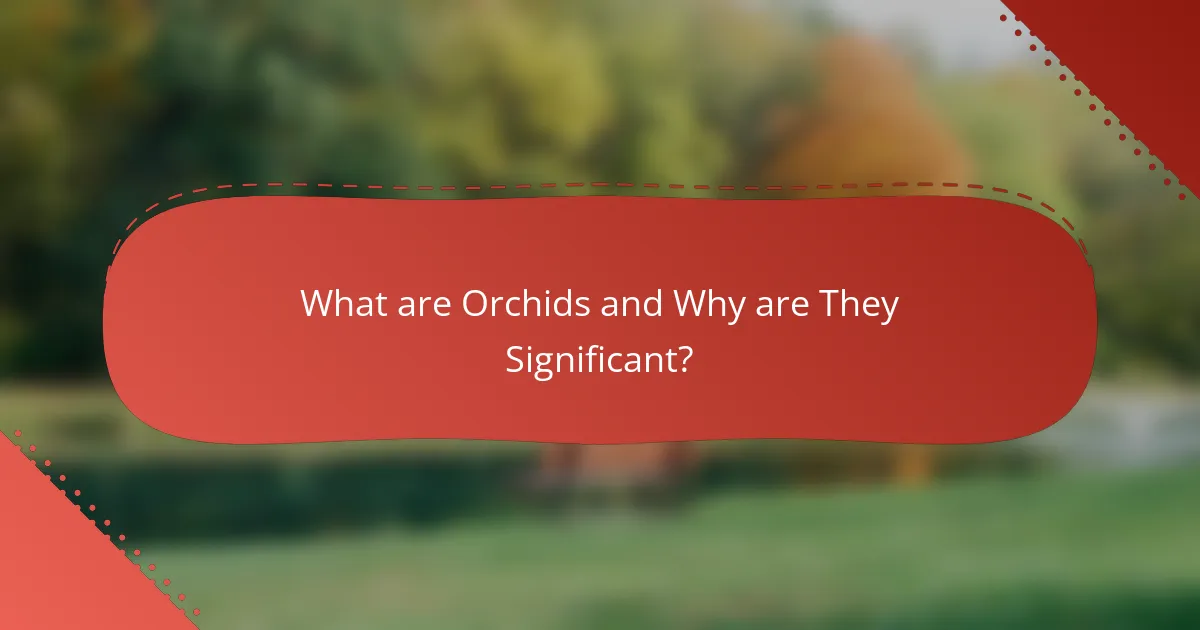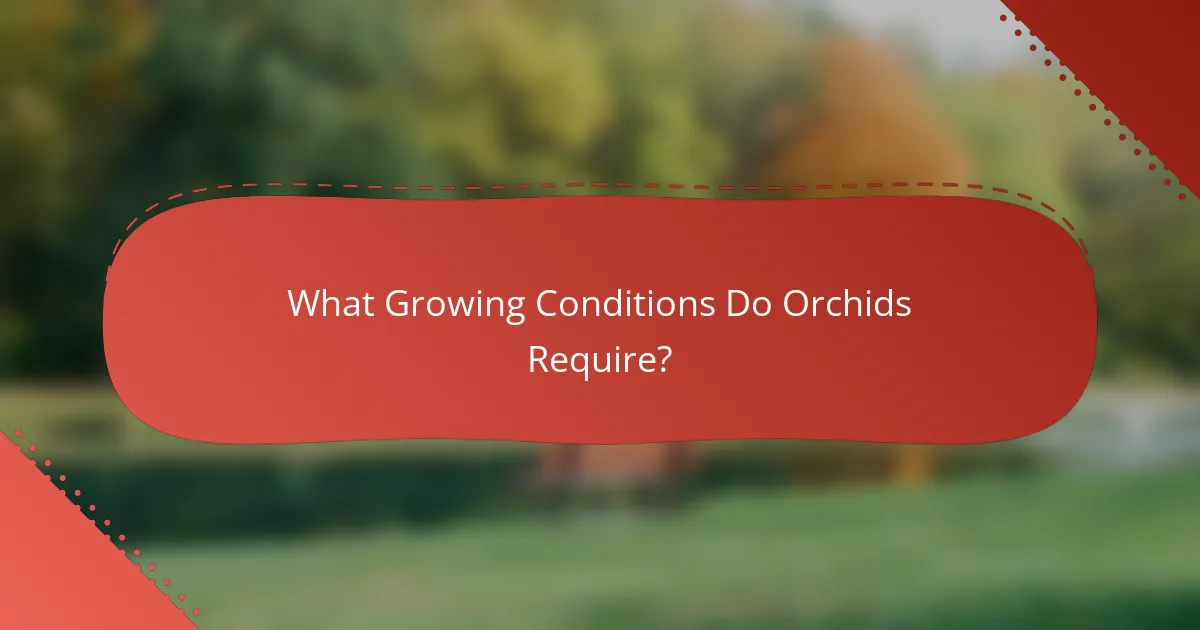
What are Orchids and Why are They Significant?
Orchids are a diverse family of flowering plants known as Orchidaceae. This family includes over 25,000 species and is recognized for its unique floral structures. Orchids are significant for their ecological roles, as they provide food for various pollinators, including bees and butterflies. They are also valued in horticulture for their beauty and variety. Additionally, orchids have cultural importance in many societies, symbolizing love, beauty, and strength. Their ability to thrive in various environments demonstrates their adaptability. Some orchids, like vanilla orchids, have economic significance due to their use in food and fragrance industries.
How many varieties of orchids exist?
There are approximately 25,000 to 30,000 recognized varieties of orchids. This number includes both natural and hybrid species. Orchids belong to the family Orchidaceae, which is one of the largest plant families. They are known for their diverse forms and colors. The variety of orchids can be found in nearly every part of the world. They thrive in different environments, from tropical rainforests to arctic tundras. The vast number of species is a result of extensive evolution and adaptation.
What are the most popular orchid species?
The most popular orchid species include Phalaenopsis, Cattleya, Dendrobium, and Oncidium. Phalaenopsis, also known as the moth orchid, is favored for its long-lasting blooms. Cattleya orchids are prized for their large, fragrant flowers. Dendrobium orchids are known for their diverse colors and shapes. Oncidium orchids, often called dancing lady orchids, are recognized for their unique flower formations. These species are commonly cultivated due to their beauty and relatively easy care requirements. Their popularity is reflected in widespread availability in nurseries and garden centers.
What unique characteristics define different orchid varieties?
Different orchid varieties are defined by unique characteristics such as flower shape, color, and size. For example, Phalaenopsis orchids have flat, broad flowers. Cattleya orchids are known for their large, vibrant blooms. Dendrobium orchids often feature smaller, clustered flowers. Additionally, some orchids have specific growth habits. For instance, Vanda orchids grow as epiphytes and require high humidity. Oncidium orchids are recognized for their fragrant flowers. Each variety also has distinct care requirements, affecting light, water, and temperature needs. These traits contribute to the diverse appeal of orchids among enthusiasts and collectors.
What are the key attributes of orchids?
Orchids are a diverse group of flowering plants known for their unique characteristics. They belong to the family Orchidaceae, which includes over 25,000 species. A key attribute of orchids is their complex flower structure, which often features bilateral symmetry. Another important attribute is their specialized pollination mechanisms, which can involve specific insects or birds. Orchids also exhibit a wide range of colors and patterns, enhancing their appeal. Additionally, they can have various growth forms, such as epiphytic, terrestrial, or lithophytic. Their roots are often adapted for moisture absorption and aeration. Many orchids have a long lifespan, with some species living for decades under optimal conditions. These attributes contribute to their popularity among plant enthusiasts and collectors.
How do orchids reproduce?
Orchids reproduce through both [censured] and asexual methods. [censured] reproduction involves pollination, where pollen from the male part (anther) is transferred to the female part (stigma) of another flower. This process often requires pollinators like bees or butterflies. Once fertilized, the ovary develops into a seed pod. Asexual reproduction occurs through vegetative propagation, where new plants grow from parts of the parent plant, such as pseudobulbs or keikis. Orchids have a unique seed structure, containing very small seeds that require specific conditions to germinate. This dual method of reproduction allows orchids to adapt and thrive in various environments.
What are the common forms of orchids?
Common forms of orchids include epiphytic, terrestrial, and lithophytic. Epiphytic orchids grow on other plants, using them for support. They thrive in humid environments and get nutrients from the air and rain. Terrestrial orchids grow in soil and are rooted in the ground. They often require well-drained soil and specific light conditions. Lithophytic orchids grow on rocks and have adaptations to absorb moisture from the air. These forms are distinguished by their growth habits and environmental needs. Each form has unique characteristics that enable survival in different habitats.

What Growing Conditions Do Orchids Require?
Orchids require specific growing conditions to thrive. They prefer a warm and humid environment, with temperatures ranging from 65°F to 75°F during the day and 60°F to 65°F at night. Orchids need bright, indirect light for optimal growth. Direct sunlight can cause leaf burn.
Proper air circulation is essential to prevent fungal diseases. Orchids thrive in well-draining potting media, such as bark or sphagnum moss. Regular watering is crucial, but overwatering must be avoided. Orchids typically need to be watered every 1 to 2 weeks, depending on humidity and temperature.
Fertilization is also important; a balanced orchid fertilizer should be applied every two weeks during the growing season. These conditions mimic their natural habitat, which is often tropical or subtropical.
How does light influence orchid growth?
Light significantly influences orchid growth by affecting photosynthesis and blooming. Orchids require specific light levels to thrive. Insufficient light can lead to weak growth and fewer flowers. Conversely, excessive light may cause leaf burn. Most orchids prefer bright, indirect light. For example, Phalaenopsis orchids thrive in 1000 to 2000 foot-candles of light. Proper light exposure enhances chlorophyll production. This process is essential for energy conversion in plants. Research indicates that light quality, intensity, and duration affect flowering cycles. Studies show that orchids bloom more prolifically with optimal light conditions.
What is the ideal light level for different orchid types?
The ideal light level for different orchid types varies by species. Phalaenopsis orchids thrive in low to medium light, around 1,000 to 2,000 foot-candles. Cattleya orchids prefer bright light, typically 2,500 to 3,000 foot-candles. Dendrobium orchids require moderate to bright light, around 2,000 to 3,000 foot-candles. Vanda orchids need very bright light, ideally 3,000 to 5,000 foot-candles. Oncidium orchids grow best in medium light, approximately 1,500 to 2,500 foot-candles. These light levels ensure optimal growth and blooming for each orchid type. Proper light conditions contribute to the overall health of orchids.
How can light conditions be adjusted for indoor orchids?
To adjust light conditions for indoor orchids, provide bright, indirect light. Orchids thrive in environments that mimic their natural habitats, which often include dappled sunlight. Use sheer curtains to diffuse direct sunlight. This prevents leaf burn while still offering adequate light. Rotate the orchids regularly to ensure even light exposure. Monitor the plant’s response; yellowing leaves indicate too much light, while dark green leaves suggest insufficient light. Adjust the distance from windows based on these observations. Supplemental grow lights can be used during low-light months. These adjustments help maintain healthy growth and blooming cycles.
What role does temperature play in orchid cultivation?
Temperature significantly influences orchid cultivation. Orchids thrive within specific temperature ranges. Most orchids prefer daytime temperatures between 70°F and 85°F. Nighttime temperatures should ideally drop to 60°F to 70°F. Consistent temperature variations promote healthy growth and flowering. Extreme temperatures can lead to stress and hinder development. Research indicates that temperature fluctuations stimulate blooming in certain orchid species. Maintaining optimal temperature conditions is crucial for successful orchid cultivation.
What are the temperature preferences of various orchid species?
Orchid species have varying temperature preferences based on their native habitats. Generally, orchids can be categorized into three temperature groups: warm, intermediate, and cool. Warm orchids thrive in temperatures between 70°F to 85°F (21°C to 29°C). Intermediate orchids prefer 65°F to 75°F (18°C to 24°C). Cool orchids grow best in temperatures ranging from 60°F to 70°F (15°C to 21°C).
For example, Phalaenopsis orchids prefer warm temperatures, while Cymbidium orchids favor cooler conditions. Dendrobium orchids often thrive in intermediate temperatures. These preferences are crucial for their growth and blooming. Maintaining appropriate temperatures ensures healthy development and vibrant flowers.
How can temperature fluctuations affect orchid health?
Temperature fluctuations can negatively impact orchid health. Orchids thrive in stable temperatures, typically between 65°F to 75°F (18°C to 24°C). Sudden changes can stress the plants. Stress may lead to wilting, leaf drop, or poor flowering. For example, temperatures below 50°F (10°C) can cause irreversible damage. Conversely, excessive heat above 85°F (29°C) can also hinder growth. Maintaining consistent temperature is crucial for optimal orchid health.

What is the Longevity of Orchids?
Orchids can live for several years, often ranging from 5 to 20 years depending on the species and care. Some orchids, like Phalaenopsis, are known to thrive for over a decade with proper conditions. Factors influencing longevity include light, temperature, humidity, and watering practices. Healthy orchids can produce blooms multiple times a year, adding to their lifespan appeal. Regular repotting and appropriate fertilization also contribute to their longevity. With the right care, some orchids may even outlive their owners, showcasing their resilience.
How long can orchids live under optimal conditions?
Orchids can live for several decades under optimal conditions. Many species can thrive for 20 to 30 years when cared for properly. Some orchids, like the Phalaenopsis, are known to last even longer, potentially reaching 50 years. Factors contributing to their longevity include appropriate light, temperature, humidity, and watering practices. With the right care, orchids can produce blooms annually for many years. This resilience makes them a popular choice among plant enthusiasts.
What factors contribute to the longevity of orchids?
The longevity of orchids is influenced by several key factors. Proper care, including appropriate watering, is essential. Orchids thrive in well-draining potting media. Humidity levels should be maintained between 40% to 70%. Adequate light is crucial; most orchids prefer indirect sunlight. Temperature control also plays a significant role; many orchids flourish in temperatures between 65°F to 75°F during the day. Fertilization, using a balanced orchid fertilizer, supports healthy growth. Pests and diseases must be managed to prevent damage. Lastly, repotting every one to two years promotes root health and longevity.
How can care practices extend the life of orchids?
Proper care practices can significantly extend the life of orchids. Providing adequate light is crucial; orchids thrive in bright, indirect sunlight. Maintaining optimal humidity levels between 40-70% helps prevent stress. Regular watering, allowing the medium to dry slightly between sessions, is essential for root health. Fertilizing with a balanced orchid fertilizer every 2-4 weeks promotes growth and flowering. Ensuring proper air circulation prevents fungal diseases, which can harm the plant. Repotting every 1-2 years refreshes the growing medium and supports root development. These care practices, when consistently applied, can lead to a longer lifespan for orchids.
What common issues affect orchid longevity?
Common issues that affect orchid longevity include improper watering, inadequate light, and poor air circulation. Overwatering can lead to root rot, which is detrimental to orchids. Insufficient light can hinder photosynthesis, essential for growth and blooming. Additionally, low humidity levels can cause stress, affecting overall health. Pest infestations, such as aphids or mealybugs, can also weaken orchids. Nutrient deficiencies may result from poor soil quality or lack of fertilization. Lastly, temperature fluctuations can stress orchids, impacting their lifespan. Each of these factors plays a significant role in the health and longevity of orchids.
How can pests and diseases impact orchid lifespan?
Pests and diseases significantly reduce orchid lifespan. Infestations by pests like aphids and spider mites weaken plants. They cause stress and hinder nutrient absorption. Diseases such as root rot and fungal infections lead to decay. This decay can ultimately kill the orchid if untreated. Regular monitoring and proper care can mitigate these risks. Studies show that healthy orchids can live for decades, while affected ones may perish within a few years. Therefore, maintaining pest and disease control is essential for longevity.
What are the signs of an unhealthy orchid?
Signs of an unhealthy orchid include yellowing leaves, wilting, and stunted growth. Yellowing leaves often indicate overwatering or nutrient deficiency. Wilting can result from underwatering or root rot. Stunted growth suggests insufficient light or poor soil conditions. Additionally, black or mushy roots indicate decay. Pests like aphids or mealybugs may also signal poor health. Lastly, lack of blooms can reflect stress or inadequate care. Recognizing these signs helps in taking corrective action.
What are the best practices for caring for orchids?
Provide orchids with bright, indirect light for optimal growth. They thrive in temperatures between 65°F and 75°F. Water orchids when the potting medium feels dry, typically every 1-2 weeks. Use a well-draining potting mix, such as bark or sphagnum moss. Fertilize orchids every 2-4 weeks during the growing season with a balanced fertilizer. Ensure good air circulation around the plants to prevent mold and pests. Repot orchids every 1-2 years to refresh the potting medium. Monitor for pests like aphids and mealybugs, treating them promptly.
How often should orchids be watered for optimal growth?
Orchids should be watered every 7 to 10 days for optimal growth. This frequency allows the roots to absorb moisture without becoming waterlogged. Overwatering can lead to root rot, which is detrimental to orchids. The specific watering needs may vary based on the type of orchid and environmental conditions. For example, orchids in warmer climates may require more frequent watering. Conversely, those in cooler environments may need less. It’s important to check the potting medium; if it feels dry, it’s time to water. Additionally, using room temperature water can help maintain root health.
What nutrients do orchids need for healthy development?
Orchids need nitrogen, phosphorus, potassium, calcium, magnesium, and sulfur for healthy development. Nitrogen supports leaf growth and overall plant health. Phosphorus promotes root development and flowering. Potassium enhances drought resistance and improves flower quality. Calcium strengthens cell walls and supports growth. Magnesium is essential for photosynthesis. Sulfur plays a role in protein synthesis. A balanced fertilizer can provide these nutrients effectively.
Orchids, belonging to the Orchidaceae family, encompass over 25,000 species recognized for their unique floral structures and ecological significance. This article explores the diverse varieties of orchids, their specific growing conditions, and factors influencing their longevity. Key topics include popular species, ideal light and temperature requirements, and essential care practices to ensure healthy growth. Additionally, the article addresses common issues that affect orchid lifespan and best practices for maintaining these resilient plants.
